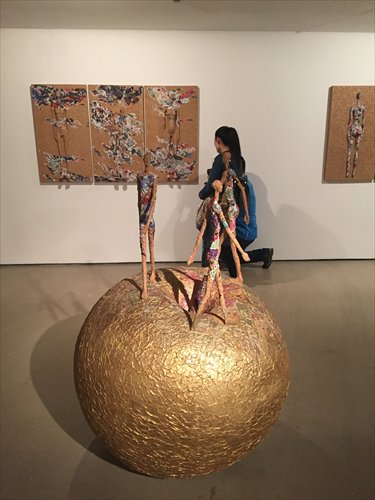Sex, money and art
Pioneer sculptor Wu Shaoxiang delves into taboo subjects

Artworks by Wu Shaoxiang are on display at the Today Art Museum in Beijing on Saturday. Photo: Lu Qianwen/GT
Now that sex and money are no longer the taboos in the language of Chinese art as they once were before 1985, sculptor Wu Shaoxiang, who was once thrown into the limelight due to his bold approach to "sex" in his art during the mid-1980s, has now chosen to continue to delve into the complicated relations between those two symbols and art.
One of the most representative artists from China's 1985 Art Movement, during which a group of young artists ushered in a great wave of new liberated art by turning away from traditional artistic values and styles, Wu is seen by many as a founding member of modern sculpture in China.
"When I was preparing for my upcoming book The Art History of Contemporary Chinese Sculpture, the first name that popped up in my mind was Wu Shaoxiang," said Xu Liang, who just curated the largest solo-exhibition Wu has held in China since the latter left the country in the late 1980s and settled in Europe (The artist currently resides in Austria).
Opened Saturday at the Today Art Museum in Beijing, Desire Scenery features dozens of sculptures Wu has created from the 1980s until now, not only unfolding a complete picture of the creative path the artist has followed, but also bringing visitors back to that special historic period when Wu's works surprised society and opened people's minds.
The forbidden language
Touched by the geometry seen in the works of Romanian sculptor Constantin Brancusi and the irregular holes featured in the works of British sculptor Henry Spencer Moore, Wu drew on their abstract art styles - still a very unfamiliar form in a society dominated by realist art introduced from the former Soviet Union - to bring a fresh style to the realm of Chinese art.
With the geometric lines in his works molded in a way that obviously entailed sexual cues, Wu's works opened people's eyes while also making them feeling a bit disturbed. "Topics about sex were seriously forbidden in the early 1980s. It was not just related to the 'sexual parts' we understand today, but humanity and politics," said Wu.
During a time when wearing a slightly bright-colored shirt would cause people on the street to point at you, Wu's works certainly touched a sensitive nerve in society. A teacher at the Central Academy of Craft Art (today's Academy of Arts & Design at Tsinghua University) in the mid-1980s, Wu was regarded as a disturbed rarity.
"[Leaders from] the college often came to me, warning that if I made more those types of works, I would be fired," said Wu.
Despite some roadblocks, Wu and other pioneering artists like Bao Pao and Wang Keping soon inspired people to examine and reflect on the left-leaning art in the country. Over time Western art styles and taboos like sex and politics in art became increasingly accepted across the nation.
"Before the 1985 Art Movement all that we had experienced was collectivism, but Wu's works showed respect for individuals, an individual's life, desire and emotions," said Yin Shuangxi, co-curator for the current exhibition. "They (Wu and his generation) overcame a lot to pioneer a space for the development of contemporary Chinese art. Many famous artists today grew from that period."
The pervasive 'money' problem
Like many other famous artists then, Wu left for the West in 1989 to further his creativity. Hoping that his works could reflect the popular culture and people's thoughts, Wu turned to the subject of money, a topic that had just started to emerge in the realm of art.
"The topic of the relationship between money and art was still taboo in the West in the late 1980s. Art was viewed as a noble thing which had nothing to do with money, until Jeff Koons' works began to make impact," Wu explained to the Global Times. "But even now most artists in the West still shun away from talking about [the relationship between] money and their work."
While most visitors can easily interpret Wu's later sculptures including those made of coins and paper money as attacks on materialism and consumerism, the artist actually is constantly delving into the question of how art and money function with each other. Although the era when this topic reigned supreme has passed, Wu believes that this topic will always be relevant since the interaction between money and art will never cease.
"What money has brought to art can been observed anywhere in the world. Before the 1980s many artists in the West were against money, but when pop art appeared in the 1990s, many artists' works were actually made for money, for auctions and to set record prices. This is also the case in the East, as many artists hope to get rich overnight," Wu said.